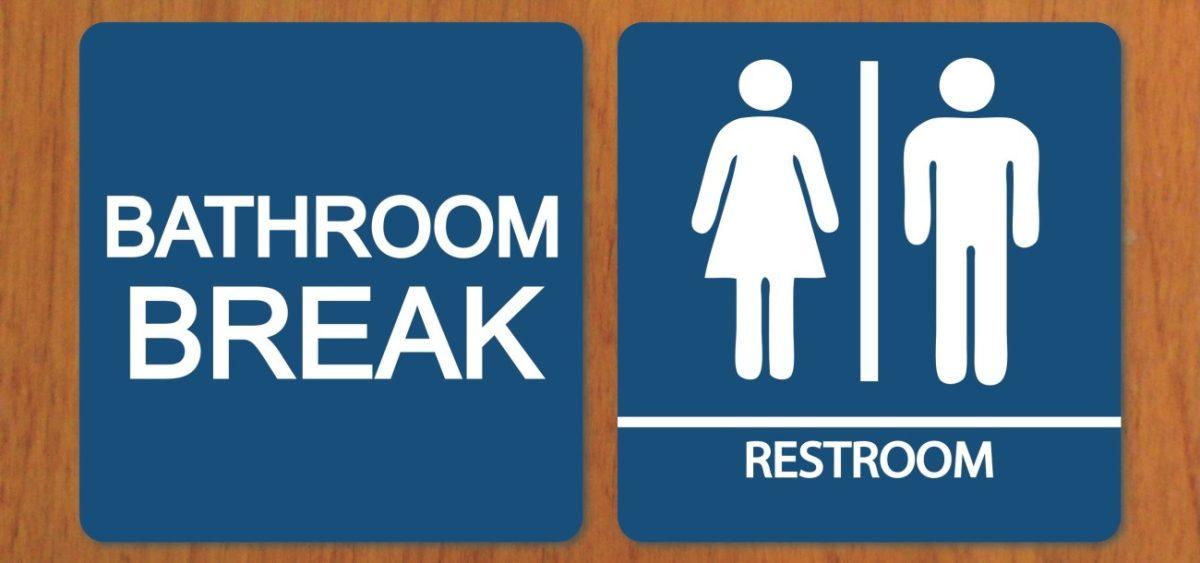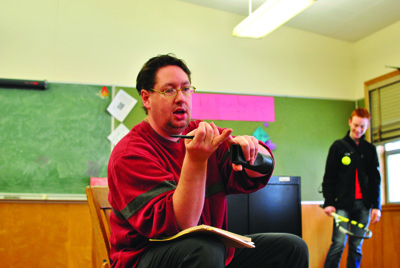Scott Morrison remembers the time he thought he was going to burst. It was shortly after 1 p.m. and students at Grant High School casually walked down the hall to their next class.
Morrison, a senior who is transgender, had to use a bathroom badly. But for the 17-year-old who is female but has identified as male since he was a small kid, using a bathroom at school was not an option. He would go into the women’s bathroom if he had to, but he didn’t like it.
“I did not drink liquids from the hours of 6 a.m. and 3:30 p.m.,” says Morrison. “If I had to drink something, I’d go into the women’s bathroom. I would rather feel kind of unpleasant (in there) than terrified in the men’s bathroom.”
Today, that has all changed. Grant has 10 students who openly identify as transgender, according to school administrators. That prompted the administrative team, led by Vice Principal Kristyn Westphal, to make a move to create unisex bathrooms at Portland’s biggest high school.
Four student bathrooms and two staff bathrooms – all single stalls – have been designated as unisex, for use by all students no matter their gender or sexual orientation.
Westphal, a key player in the completion of this project, says most people use bathrooms without a second thought. But for transgender youth, something had to be done, she says. “It was directly related to equity, and that’s something that the district really prioritizes,” she says.
Westphal and the Grant administration had other motivation. One of the top reasons transgender students – who already face potentially negative treatment from others – drop out of high school is because they feel uncomfortable going to the bathroom.
And while a number of schools across the country have clubs that support gay, lesbian and transgender students, creating a safer environment for transgender students has begun to percolate as a leading issue in education.
In Colorado, for example, a six-year-old transgender girl was forbidden from using the girl’s bathroom at her public school because officials said other students would be uncomfortable with her presence in the female restroom. Her parents took her out of school and filed a discrimination report against the school.
Experts say the attention on such cases helps with understanding, especially when it comes to the media.
“Not long ago, we saw almost uniformly negative coverage of transgender people. While we still need to do a lot of work, the fact that we’re seeing more balanced coverage is a huge
step forward,” says Tara Borelli, a senior attorney at Lambda Legal, a Los Angeles law firm that specializes in gay, lesbian and transgender issues.
Bethprana Novi, a clinical social worker in private practice in Northeast Portland who used to be a counselor at Grant, says the school’s diverse culture has made unisex bathrooms possible. “We are seeing a movement that we saw with homosexuality 10 or 15 years ago. The awareness is rising, and with education comes civil rights. Things are definitely changing,” she says.
 For students like Morrison, 17, not having unisex bathrooms created a distraction. He couldn’t always concentrate at school. He had to strategically plot out his day, including figuring out if he could hold it long enough after school to make it home to the bathroom.
For students like Morrison, 17, not having unisex bathrooms created a distraction. He couldn’t always concentrate at school. He had to strategically plot out his day, including figuring out if he could hold it long enough after school to make it home to the bathroom.
Morrison has felt transgender for a long time. But he says finding out that you’re transgender doesn’t happen overnight. From when he was a child living in Virginia, Morrison always dressed like a boy. “I would scream when my grandmother tried to put me in dresses,” Morrison says. But he didn’t feel singled out when he was younger for the early signs of his transgender behavior. “Little girls being tomboys is more accepted than little boys wearing dresses,” he says.
In middle school, Morrison worked hard to fit in. When all of the other boys were wearing football jerseys, Morrison asked his father to buy him one. “I felt so awesome in that thing even though I didn’t know anything about football,” he says.
But no matter how hard he tried to be one of the guys, Morrison was bullied. “I tried as hard as I could to not make any enemies,” he says.
His family moved to Portland when Morrison’s mother got a new job. That was when he decided to reveal his secret. Morrison, then 15, sat down with his mother in his bedroom and asked the question: What would you say if I said that I wanted to be a boy? His mother responded with: “Well, whatever makes you happy.” While he still feels like it’s a work in progress, Morrison feels more like himself. “When you come out, it’s the happiest thing in your life,” he says.
Morrison’s parents have been supportive, and in January he started hormone therapy, a process to replace estrogen in his body and begin the physical transformation.
One day this year when Morrison was meeting with counselor Liz Mahlum, he told her how getting on hormones would make it difficult to focus in class, and the topic of bathroom avoidance came up.
“I just want people to understand that it’s really difficult to be transgender. I have had my fair share of anorexia, self harm, and if there is just one thing that can make that better, I am so appreciative of that,” he says.
Becca Dorn-Medieros is Grant’s school psychologist. She says for her it comes down to how can you provide the best experience for all students and avoid having a sense of exclusion that falls to a handful of the population. In the end, she says, it’s an equity issue.
“Gendered bathrooms present an issue for any gender nonconforming people, whether or not they identify as transgender,” Dorn-Medieros says. “It’s a huge safety issue for people.”
Sixteen states, as well as Washington, D.C., have laws and policies prohibiting discrimination based on sexual orientation and gender identity. Oregon is one of them. The legislature approved the Oregon Equality Act in 2007 and it went into effect the following year. A piece of the law prohibits gender identity discrimination in public schools.
“The Oregon Equality Act itself carries a very strong statement of purpose, leaving no doubt about Oregon’s commitment to eradicating discrimination based on sexual orientation and gender identity, among other characteristics,” says Borelli.
While there is no Oregon case that states directly the requirement to provide unisex bathrooms, “The act must be understood to encompass that form of equality,“ she says.
This year, some of the transgender students expressed to counselors that they needed a separate bathroom. More of the students said they were uncomfortable using a strictly male or female bathroom.
Westphal, who meets weekly with the team of school counselors, decided to move forward after she talked to Principal Vivian Orlen. After all, Portland Public Schools equity rules call for a “safe environment for all students” in every school. Without bathrooms fit for every student, those rules weren’t being met.
Grant administrators decided to move on the issue. After a student support team meeting including counselors and various administrators in the building, Westphal took the lead.
She called the district facilities office and the plan was hatched to open three unisex bathrooms during the 2012-2013 school year.
Michelle Chariton, the senior project manager at PPS Facilities & Asset management, says Oregon building code doesn’t take transgender population needs into account. The challenge maintenance staff face in installing unisex bathrooms is the need to make sure enough restrooms are available for both genders to meet code.
The district responded quickly to the request because “access to an adequate bathroom facility is a basic need that all students should have met,” according to district spokesman Matt Shelby.
Westphal was happy with the way things turned out. “A month seems like a long time, but in the general scheme of things, it’s actually really fast to make it happen,” she says.
Orlen, who came to Grant from the New York City school system three years ago, says converting the bathrooms was a way to find a solution that likely wouldn’t have been addressed. She notes that unisex bathrooms in New York schools have been around for at least a decade.
“I am really proud that we have taken the lead in PPS to make this happen for our students,” she says. “It helps us be a better school for everyone.”
It’s not just transgender students who benefit from unisex bathrooms. Many gay and lesbian students say they will feel more comfortable using unisex bathrooms. Sophomore Alexa Booher says it’s “fantastic” because it would make students of all genders and sexualities feel more comfortable.
For Booher, because her hair is short and she dresses more masculine, some people mistake her as a guy. She often gets stared at and faces strange looks from girls when she is in the girl’s bathroom because she doesn’t “look like a girl.”
“It was right after I cut off my hair,” Booher says.
Senior Sophie Kidd-Myers, an active member of Grant’s Gay-Straight Alliance, says without unisex bathrooms, transgender students had to make a tough choice when using the restroom: stay true to their gender identity or follow their birth gender. “I support gender neutral bathrooms,” Kidd-Myers says. “I feel uncomfortable going into the female bathroom because I am not that feminine.”
Kidd-Myers says gender shouldn’t define her. “I would rather be a person than a gender,” she says.
The unisex bathrooms at Grant have been in place since late February and so far there has been no blowback. The changes were announced to staff and affected students were notified of the new choices.
Administrators say they aren’t planning an assembly or announcement because they don’t want to put a spotlight on an already vulnerable population. They want all students to understand why the changes were necessary. “Many people don’t understand the context of it,” says Orlen. “An announcement wouldn’t give the right message.”
Instead, Orlen says, school officials will postpone the “larger discussion” until later, though they don’t have anything planned.
“It folds really nicely into the work that we have done around bullying and acceptance, and trying to make sure that everyone feels safe and at home here,” Westphal says. ♦




































